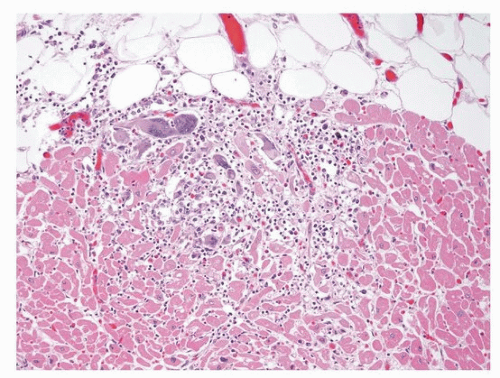Giant Cell Myocarditis
Allen P. Burke, M.D.
Pathogenesis
Historically termed “Fiedler myocarditis,”1 giant cell myocarditis is a rare disorder with unclear cause. An autoimmune cause is likely, because patients often have concomitant autoimmune disorders (up to 8% in one series).2 Table 165.1 lists diseases that have been associated disease with giant cell myocarditis.
The etiology of the giant cells, which are present by definition, is unclear, but likely related to macrophage engulfment of necrotic myocytes. There is some overlap with necrotizing eosinophilic myocarditis, which may elicit a giant cell reaction due to extensive necrosis (see Chapter 27).20 There are occasional reported cases that suggest an enteroviral trigger.21
Clinical Findings
Giant cell myocarditis most often affects young to middle-aged adults, although several case reports in children as early as 10 days old have been documented.23,24 There is a slight male predominance.
Most cases of giant cell myocarditis follow a rapidly deteriorating course (days to months) from congestive heart failure to cardiogenic shock that is often unresponsive to conventional treatments. During the course of the illness, ventricular tachycardia is noted in a high percentage of the patients.25 The initial presenting symptoms may also be sudden death.26
In a subset of patients, early symptoms are those of lymphocytic myocarditis or myopericarditis with more gradually progressive heart failure.27
TABLE 165.1 Selected Reported Autoimmune Disorders Associated with Giant Cell Myocarditis | ||
|---|---|---|
|
Rarely, giant cell myocarditis can be an incidental finding, especially if isolated to the atria (see below)28 (Fig. 165.1).
Stay updated, free articles. Join our Telegram channel

Full access? Get Clinical Tree



